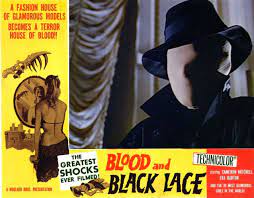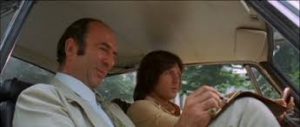
© International Apollo Films / Les Films Corona / Atlantida Films
Not so long ago, I caught up with Edgar Wright’s 2021 movie Last Night in Soho. I generally liked it, though I thought its first half was more successful than its second. During the first half the film is very much a fantasy, with a lonely young woman (Thomasin McKenzie), who’s fixated on 1960s British fashion and culture, arriving in unglamorous, modern-day London and falling victim to weird, time-travelling regressions. These send her back six decades and put her soul in the body of an early-1960s starlet (Angela Joy-Taylor) who’s trying to make her name in Soho, the London district that embodied the era’s combination of carefree glamour and shady decadence. Halfway through, however, the movie shifts gears. The 1960s scenes become sourer and darker and the fantasy gives way to horror. This transition didn’t quite work for me and I ended up feeling the movie was neither fish nor fowl.
One thing I thought was cool about Last Night in Soho’s second, macabre half, however, was how Wright invests it with the aesthetics of Italian giallo cinema. There’s bright, lurid lighting and colours, and swirling camerawork, and lots of splashy, slashy blood and grue. Wright has obviously studied the works of old giallo maestros like Mario Bava, Sergio Martino, Lucio Fulci and Dario Argento. And it’s giallo movies that I’d like to spend this entry talking about.
What is, or was – because, informed by a certain time, place and set of attitudes, the genre is surely obsolete in 21st century cinema – a giallo movie?
Previously on this blog, while I was paying tribute to the late Ennio Morricone, whose music embellished the soundtrack of many a giallo in the late 1960s and early 1970s, I described it as a “staple of traditional Italian cinema” that was a “horror-thriller hybrid wherein a group of people, usually affluent and beautiful, get despatched by a mysterious killer (identity revealed only in the closing moments) stabbing, slashing and hacking his or her way through them for some unlikely reason. The results are often Italian films at their most glamorous, stylish, violent, ridiculous and politically incorrect.” Incidentally, the word giallo is Italian for ‘yellow’ and, according to Wikipedia, the cinematic term “derives from a series of cheap paperback mystery and crime thrillers with yellow covers that were popular in Italy.”
There follows a list of my favourite gialli. I should point out that I’m a purist about what constitutes and doesn’t constitute a giallo. In my mind, the ’killer’ element is important. It’s got to be a human doing the killing, not a monster or supernatural agency. So, though I’ve seen other people’s lists of gialli include films like Elio Petri’s A Quiet Place in the Country (1968), Mario Bava’s Hatchet for the Honeymoon (1970) and Lisa and the Devil (1974), Emilio Miraglia’s The Night Evelyn Came Out of the Grave (1971) and Dario Argento’s Suspiria (1977) and Inferno (1980), I’m steering clear of them because their plots contain ghosts, witches, devils and other supernatural elements. I’m also avoiding Francisco Barilli’s Perfume of the Lady in Black (1974), which isn’t so much supernatural as Kafkaesque-ly strange. For me, a proper giallo doesn’t contain the impossible. Just, usually, the highly improbable.
Anyway, there’s only one movie to start with…

© Emmeni Cinematografica / Les Productions Georges de Beaurgard
Blood and Black Lace (1964)
Director Mario Bava was to Italian horror cinema what John Ford was to westerns or Alfred Hitchcock was to suspense movies. The form would have been utterly different without him. His splendid 1960s trilogy Black Sunday (1960), Black Sabbath (1964) and Kill, Baby, Kill (1966) indelibly shaped Italy’s tradition of gothic horror shockers. Black Sabbath and Kill, Baby, Kill were also shot in colour and showcased Bava’s eye for baroque lighting, gorgeous colour palettes and elaborate set design, which proved the frights didn’t have to come at you from a monochrome world of darkness and shadows. They could come at you from a brightly and lushly phantasmagorical world too.
Meanwhile, Blood and Black Lace is an early landmark in giallo films. Its tale of a series of murders in a Rome fashion house – invariably of young, beautiful models, which meant gialli were open to the charge of misogyny from the very start – created the template for the form. Moreover, thanks to Bava’s inimitable visual style, it’s a stunning film to watch. For my money, it’s up there with Stanley Kubrick’s 2001: A Space Odyssey (1968), Ridley Scott’s Blade Runner (1982) and Wes Anderson’s The Grand Budapest Hotel (2014) as one of those movies that’s simply a feast for the eyes.

© Seda Spettacoli / Titanus / Constantin
The Bird with the Crystal Plumage (1970)
Blood and Black Lace made the giallo mould, but The Bird with the Crystal Plumage directed by then-new kid on the block Dario Argento – this was his directorial debut – showed that this type of movie could win both popular success and critical acclaim. It also inspired a glut of gialli in Italy during the early 1970s. The story begins with a young American (Tony Musante) witnessing a near-deadly attack on a woman in a Rome art gallery – he gets trapped between two glass doors and is unable to run to her aid. While more violence occurs, seemingly as a result of the attack, he agonises over what he thought he saw. He can’t put his finger on it, but there was something not quite right about it… This ‘missing-piece-of-the-jigsaw’ trope became a common one in giallo films. Providing Bird’s music is the peerless Ennio Morricone, while in the role of Musante’s girlfriend is English actress Suzy Kendall, who would notch up more giallo credits. She even appeared as ‘special guest screamer’ in 2012’s Berberian Sound Studio, Peter Strickland’s ‘sort of’ tribute to 1970s Italian horror movies.

© Nuova Linea Cinematografica
A Bay of Blood (1971)
A Bay of Blood feels like Mario Bava’s grumpy riposte to Argento, who the previous year had made giallo films almost respectable with The Bird with the Crystal Plumage. A Bay of Blood is the polar opposite, a nasty, mean-spirited and ultra-violent effort, surely the most violent thing in Bava’s CV. It’s about a community of conniving scumbags who murder one another in their desperation to secure an inheritance, which is the expensive property around the titular bay. Even at the film’s end, when only the last two, husband-and-wife scumbags (Luigi Pistilli and Claudia Auger) remain alive, Bava hits upon a novel way of killing them off too. What makes A Bay of Blood fascinating is an extended section that’s barely connected with the rest of the film. Here, a quartet of teenagers break into the mansion at the centre of the murders and are themselves, gratuitously and bloodily, murdered. This part is less like a giallo and more like a prototype showreel for the ‘slasher’ movies, such as the Friday the 13th ones, that dominated American horror cinema in the 1980s.

© Doria G. Film / Dunhill Cinematografica / Jadran Film
Short Night of Glass Dolls (1971)
An atypical giallo, Aldo Lado’s Short Night of Glass Dolls benefits from its Prague setting and a plot that features a murderous conspiracy rather than another contrived-killer-on-the-loose scenario. Downbeat endings aren’t unusual in gialli, but the grim fate that befalls the journalist hero (French actor Jean Sorel) is genuinely affecting and disturbing. Also in the movie is Ringo Starr’s future missus Barbara Bach, who that same year would appear in a second giallo, Paolo Cavara’s The Black Belly of the Tarantula. Short Night boasts music from Ennio Morricone too. As does…
Four Flies on Grey Velvet (1971)
The final instalment in what would become known as Dario Argento’s ‘animal’ trilogy, which began with The Bird with the Crystal Plumage and continued with Cat O’ Nine Tails (made earlier in 1971), Four Flies on Grey Velvet is about a Rome-based rock drummer and his wife, played by Michael Brandon and Mimsy Farmer, another Anglophone actress who became something of a giallo star. They get involved in a series of murders after the drummer seemingly, unwittingly kills a man who’s been stalking him.

© Seda Spettacoli / Universal Productions France
One of Four Flies’ pleasures is the wonderful performance by French actor Jean-Pierre Marielle as Gianni Arrioso, a camp, incompetent and tragic private investigator hired by Brandon to figure out what’s going on. When the inevitable happens and Arrioso gets bumped off by the killer too, the dying PI consoles himself with the thought that at least, for once, he guessed the culprit’s identity correctly: “I was right,” he sighs, “I did it this time.” In another supporting role, as one of Brandon’s mates, is the great Bud Spencer, taking a break from the spaghetti westerns and comedies he was making at the time with his acting partner Terence Hill.
A Lizard in a Woman’s Skin (1971)
Much loved by horror-movie buffs for his schlocky, gory, no-rational-thought-required opuses like Zombie Flesh Eaters (1979), City of the Living Dead (1980) and The Beyond (1981), director Lucio Fulci was, once, a maker of surprisingly stylish gialli. A Lizard in a Woman’s Skin is also that fascinating beast, a giallo set in London, meaning that life in early 1970s Britain – hardly the most glamorous time or place – is depicted intriguingly, if improbably, through a more fashion-conscious, Mediterranean lens. Joining the London scenery here is the impeccable, no-nonsense Welsh actor Stanley Baker, playing a police detective investigating the killings that invariably happen. Meanwhile, there’s more Morricone goodness on the soundtrack.
Alas, Lizard suffers from being half-an-hour too long and runs out of steam towards its end. Nothing in it quite compares with its opening sequences, in which the repressed wife (Florinda Bolkan) of a high-flying lawyer (Jean Sorel again) dreams about fleeing through a packed train, whose passengers then morph into enthusiastic participants in a gigantic hippy orgy being held in the house of her real-life neighbour (Anita Strindberg, another giallo regular). The saucy dreams climax – ouch! – with a murder, and when a real murder is committed in the real house, we’re left wondering what’s actually dream and reality in Bolkan’s head.
Though the film slackens in its later stages, Fulci still manages some memorable moments, such as a set-piece chase through Alexandra Palace in north London, where Bolkan ends up in the building’s roof-space and is swarmed by a disturbed colony of bats; or an unhinged scene set in a high-security sanitorium where she blunders into a laboratory-room full of partly-dissected dogs. The dogs in the lab scene weren’t real, but the special effects, courtesy of effects-man Carlo Rambaldi (who would later create ET), seemed so realistic by the standards of the time that Fulci got threatened with a prison sentence for animal cruelty.

© International Apollo Films / Les Films Corona / Atlantida Films
More of my favourite gialli will appear in a future blog-entry!
